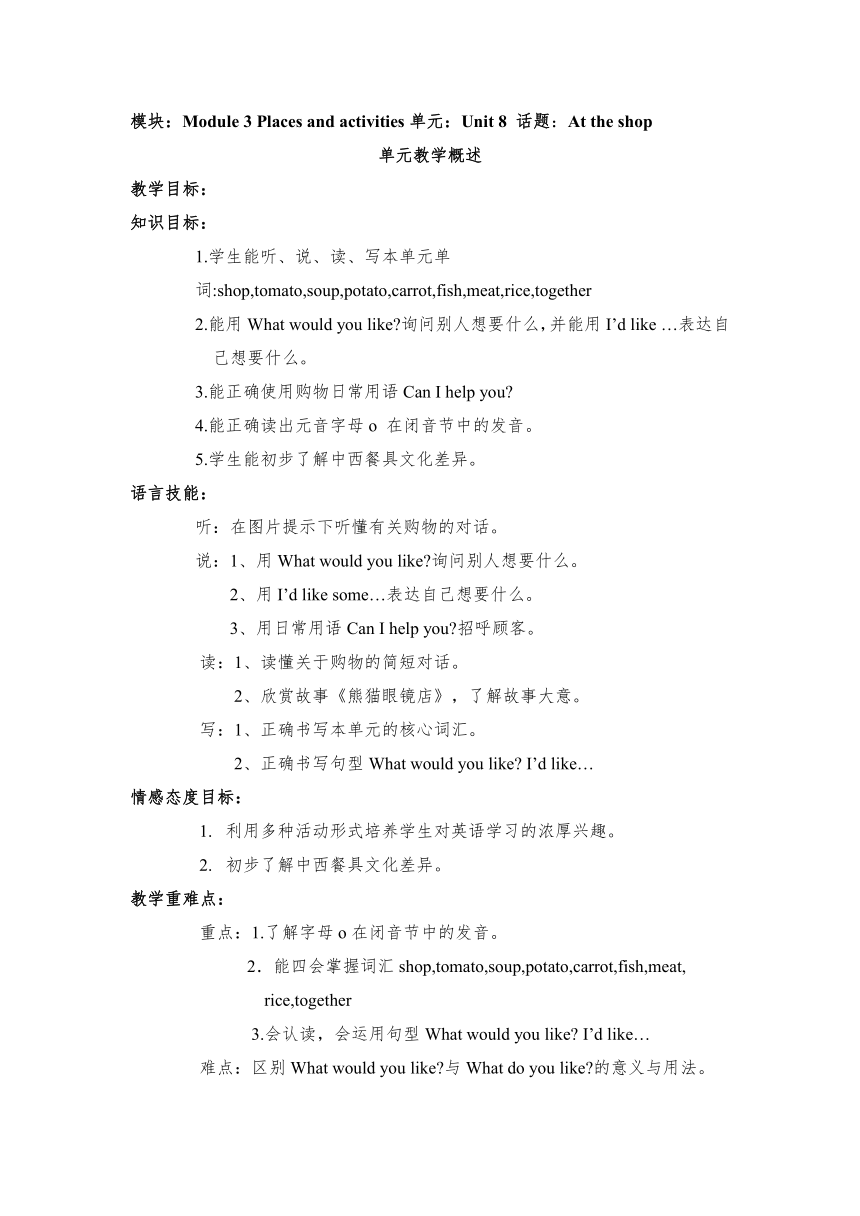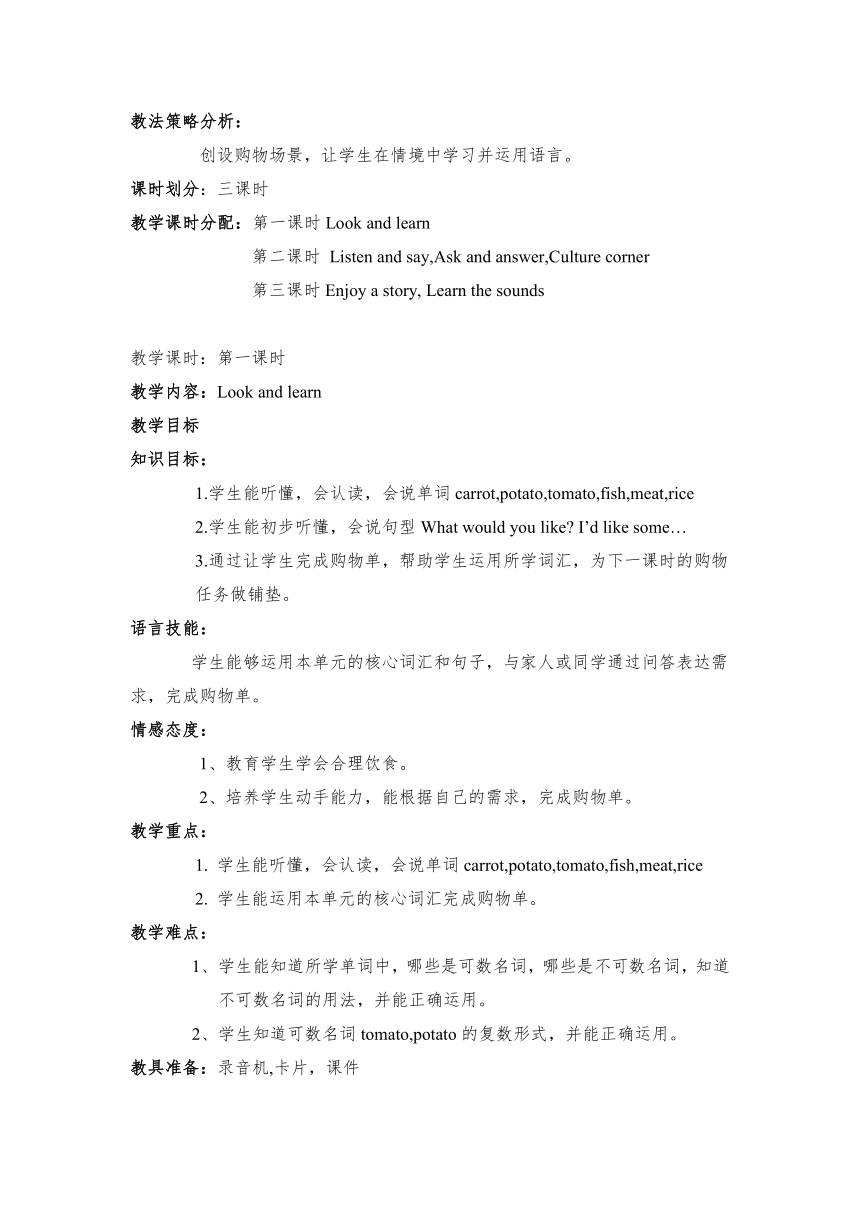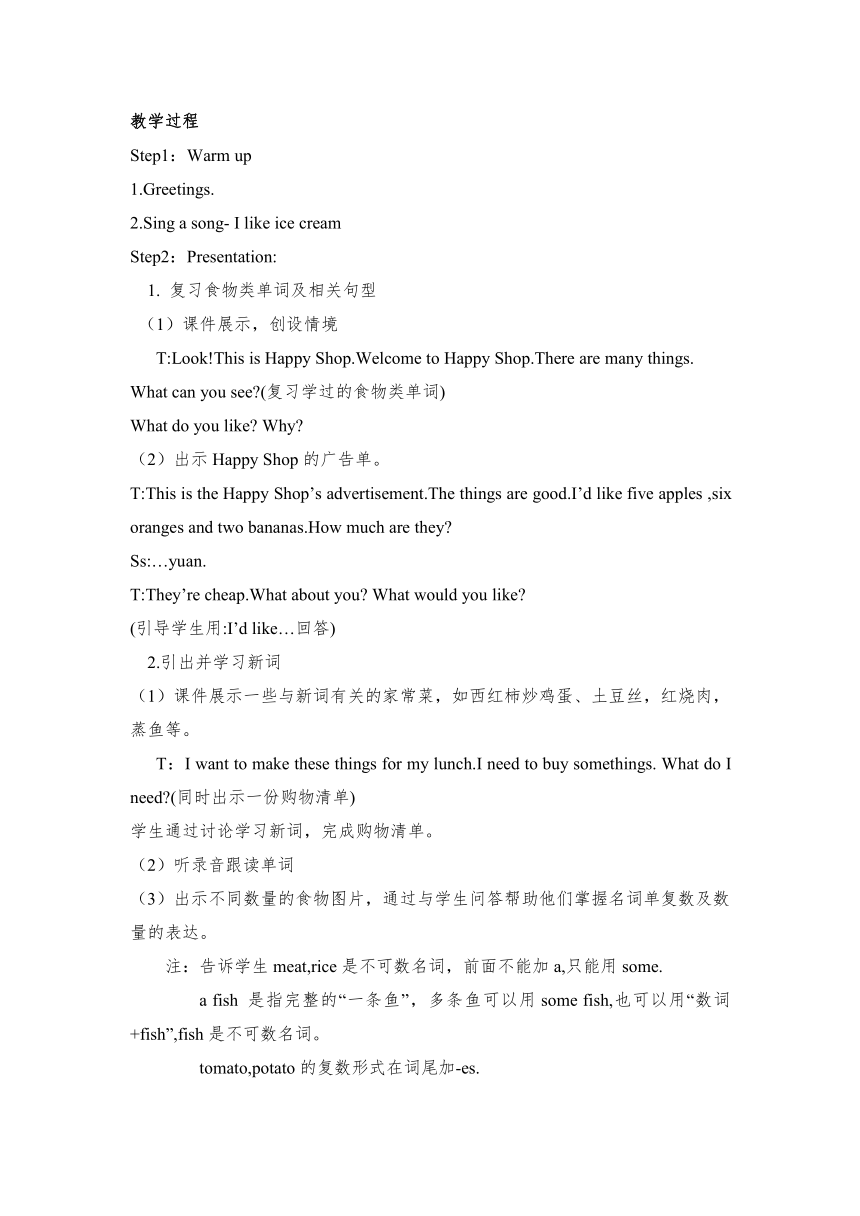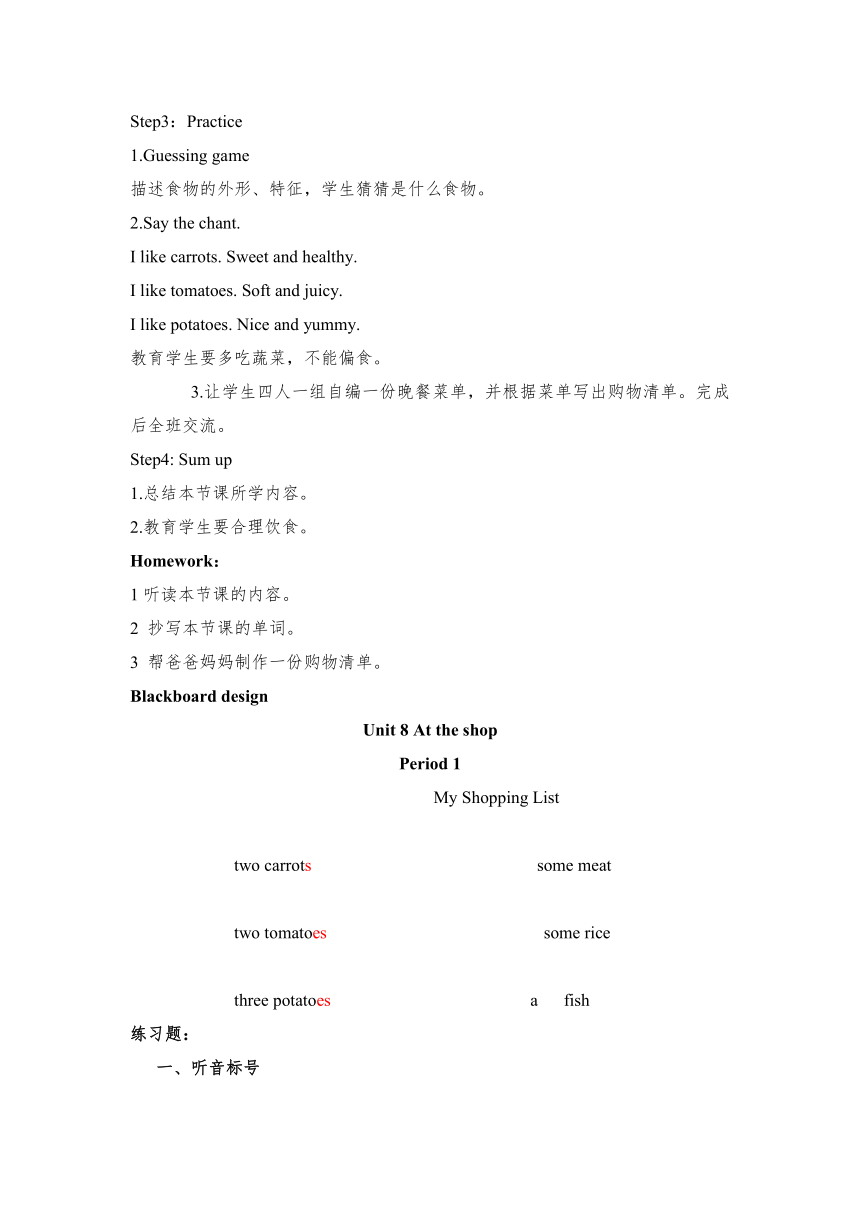Unit 8 At the shop教案 (3个课时)
文档属性
| 名称 | Unit 8 At the shop教案 (3个课时) |

|
|
| 格式 | zip | ||
| 文件大小 | 138.9KB | ||
| 资源类型 | 教案 | ||
| 版本资源 | 牛津深圳版 | ||
| 科目 | 英语 | ||
| 更新时间 | 2015-12-10 21:38:11 | ||
图片预览





文档简介
模块:Module 3 Places and activities单元:Unit 8 话题:At the shop
单元教学概述
教学目标:
知识目标:
1.学生能听、说、读、写本单元单词:sh ( http: / / www.21cnjy.com )op,tomato,soup,potato,carrot,fish,meat,rice,together
2.能用What would you like 询问别人想要什么,并能用I’d like …表达自己想要什么。
3.能正确使用购物日常用语Can I help you
4.能正确读出元音字母o 在闭音节中的发音。
5.学生能初步了解中西餐具文化差异。
语言技能:
听:在图片提示下听懂有关购物的对话。
说:1、用What would you like 询问别人想要什么。
2、用I’d like some…表达自己想要什么。
3、用日常用语Can I help you 招呼顾客。
读:1、读懂关于购物的简短对话。
2、欣赏故事《熊猫眼镜店》,了解故事大意。
写:1、正确书写本单元的核心词汇。
2、正确书写句型What would you like I’d like…
情感态度目标:
利用多种活动形式培养学生对英语学习的浓厚兴趣。
初步了解中西餐具文化差异。
教学重难点:
重点:1.了解字母o在闭音节中的发音。
2.能四会掌握词汇shop,tomato,soup,potato,carrot,fish,meat,
rice,together
3.会认读,会运用句型What would you like I’d like…
难点:区别What would you like 与What do you like 的意义与用法。
教法策略分析:
创设购物场景,让学生在情境中学习并运用语言。
课时划分:三课时
教学课时分配:第一课时Look and learn
第二课时 Listen and say,Ask and answer,Culture corner
第三课时Enjoy a story, Learn the sounds
教学课时:第一课时
教学内容:Look and learn
教学目标
知识目标:
1.学生能听懂,会认读,会说单词carrot,potato,tomato,fish,meat,rice
2.学生能初步听懂,会说句型What would you like I’d like some…
3.通过让学生完成购物单,帮助学生运用所学词汇,为下一课时的购物任务做铺垫。
语言技能:
学生能够运用本单元的核心词汇和句子,与家人或同学通过问答表达需求,完成购物单。
情感态度:
教育学生学会合理饮食。
培养学生动手能力,能根据自己的需求,完成购物单。
教学重点:
1. 学生能听懂,会认读,会说单词carrot,potato,tomato,fish,meat,rice
2. 学生能运用本单元的核心词汇完成购物单。
教学难点:
学生能知道所学单词中,哪些是可数名词,哪些是不可数名词,知道不可数名词的用法,并能正确运用。
学生知道可数名词tomato,potato的复数形式,并能正确运用。
教具准备:录音机,卡片,课件
教学过程
Step1:Warm up
1.Greetings.
2.Sing a song- I like ice cream
Step2:Presentation:
1. 复习食物类单词及相关句型
(1)课件展示,创设情境
T:Look!This is Hap ( http: / / www.21cnjy.com )py Shop.Welcome to Happy Shop.There are many things.
What can you see (复习学过的食物类单词)
What do you like Why
(2)出示Happy Shop的广告单。
T:This is the Happy S ( http: / / www.21cnjy.com )hop’s advertisement.The things are good.I’d like five apples ,six oranges and two bananas.How much are they
Ss:…yuan.
T:They’re cheap.What about you What would you like
(引导学生用:I’d like…回答)
2.引出并学习新词
(1)课件展示一些与新词有关的家常菜,如西红柿炒鸡蛋、土豆丝,红烧肉,蒸鱼等。
T:I want t ( http: / / www.21cnjy.com )o make these things for my lunch.I need to buy somethings. What do I need (同时出示一份购物清单)
学生通过讨论学习新词,完成购物清单。
(2)听录音跟读单词
(3)出示不同数量的食物图片,通过与学生问答帮助他们掌握名词单复数及数量的表达。
注:告诉学生meat,rice是不可数名词,前面不能加a,只能用some.
a fish 是指完整的“一条鱼”,多条鱼可以用some fish,也可以用“数词+fish”,fish是不可数名词。
tomato,potato的复数形式在词尾加-es.
Step3:Practice
1.Guessing game
描述食物的外形、特征,学生猜猜是什么食物。
2.Say the chant.
I like carrots. Sweet and healthy.
I like tomatoes. Soft and juicy.
I like potatoes. Nice and yummy.
教育学生要多吃蔬菜,不能偏食。
3.让学生四人一组自编一份晚餐菜单,并根据菜单写出购物清单。完成后全班交流。
Step4: Sum up
1.总结本节课所学内容。
2.教育学生要合理饮食。
Homework:
1听读本节课的内容。
2 抄写本节课的单词。
3 帮爸爸妈妈制作一份购物清单。
Blackboard design
Unit 8 At the shop
Period 1
My Shopping List
two carrots some meat
two tomatoes some rice
three potatoes a fish
练习题:
一、听音标号
carrot( ) potato( ( http: / / www.21cnjy.com ) ) meat( ) tomato( )fish( ) rice( )
二、看图写词组
------------ -----------
----------- ------------
------------- -------------
Teaching notes:
教学课时:第二课时
教学内容:Listen and say ,Ask and answer,Culture corner
教学目标
知识目标: 1.通过Listen and say的情景对话,帮助学生理解核心句型的含义和用法。
2.通过Ask and answer 的对话操练,帮助学生在模拟商店的情景中初步运用核心句型来表达意愿,购买食物。
3.通过让学生根据上一课时的购物单进行模拟购物游戏,帮助学生进一步运用所学语言来完成购物任务。
语言技能:学生能够使用购物用语表达自己的需求,成功购买所需物品。
情感态度:学生初步了解中西餐具文化的差异。
教学重点:1、学生能听懂,会说单词shop,soup
2、学生能用What would you like 询问别人想要什么,并能用I’d like…表达自己想要什么。
教学难点:学生能区分What would you like 与What do you like 的意义与用法。
教具准备:录音机、卡片、课件,一些食物图片
教学过程
Step1:Warm up
1.Greetings.
2.出示卡片,快速闪现,学生复习单词
Step 2: Presentation
1.出示书中“Ask and answer”中的图片
T:Look!This is H ( http: / / www.21cnjy.com )appy Shop!Welcome to Happy Shop!Here are many things. What can you see What do you like Why What would you like Why
引导学生比较区分What would you like 与What do you like 的意义与用法。
2.出示Mrs Li和Kitty的空白购物单(配图)
T:Mrs Li and Kitt ( http: / / www.21cnjy.com )y are at the shop.What would they like How much are they
Let’s listen.
学生边听边记录,然后回答问题,完成购物清单。
1.听录音,跟读“Listen and say”中对话
2.分角色朗读对话。
3.渗透中西方文化
(1)T: Look at Mum’s sh ( http: / / www.21cnjy.com )opping list. What can Kitty and Hermum eat for dinner
(教学单词soup)
(2)T: They are Chinese food.We can eat them with chopsticks.
(3)出示Culture ( http: / / www.21cnjy.com )corner,学生了解中西饮食餐具上的一些差异,并补充一些文化信息:中餐常用的餐具如chopsticks,plate,spoon; 西餐常用的餐具如knife,fork,spoon,西餐中左手用叉,右手用刀
Step 3: Practice
课件再次出现“Happy Shop”中的食物,同时贴上价格标签。
T:Do you like shopping Let’s go to Happy Shop.
模仿Part A,学生三人一组根据自己的需求,模拟购物场景进行购物活动。
Step4: Sum up
总结本节课所学句型及文化知识。
Homework:
1.听读本节课所学的内容
2.熟读本节课所学的对话。
3.抄写核心句型
Blackboard design
Unit 8 At the shop
Period 2
Mrs Li’s Shopping List Kitty’s Shopping List
some tomatoes some candy
some eggs some orange juice
some potatoes
some carrots
练习题:根据课文内容填空
---What ____ you_____,Mum
--I’d___ som ( http: / / www.21cnjy.com )e______ and____.We can ___some ____. I’d ___ some___ and___too.
What ___ you____,Kitty
-- I’d ___ some____. I’d ___ some ___ ___ too.
--How___ are____ --____ yuan,please.
--Here you are. -–Thank you.
Teaching notes:
教学课时:第三课时
教学内容:Enjoy a story, Learn the sounds
教学目标
知识目标: 1.通过阅读故事“Panda’s glasses shop”,帮助学生进一步巩固和运用所学句型。
2.学生能正确读出元音字母o在闭音节中的发音。
语言技能:1.学生能读懂故事“Panda’s glasses shop”,了解故事大意。
2.能正确使用购物日常用语Can I help you
情感态度:引导学生能准确理解文章的大意,培养学生良好的阅读习惯,。
教学重点:1. 学生能正确读出元音字母o在闭音节中的发音。
2. 学生能正确使用购物日常用语Can I help you
3. 学生能读懂故事“Panda’s glasses shop”
教学难点:学生能读懂故事“Panda’s glasses shop”。
教具准备:录音机、卡片,课件
教学过程
Step1:Warm up /Review
1.Greetings.
2.复习单词:填入所缺字母。
3.复习句型
课件展示Happy Shop商品,标上价格
T:Look! This is H ( http: / / www.21cnjy.com )appy Shop!Here are many things.What can you see What would you like
T: I’m a shop assistant. Welcome to Happy Shop.Can I help you
(教学句型Can I help you )
学生运用“Listen and say”中句型,表演购物场景。
Step2.Presentation
(一)Enjoy a story
1.T:I have three fr ( http: / / www.21cnjy.com )iends. Who are they Can you guess (描述panda,mouse,elephant 的外形特征,学生猜)
2.出示图片T: Look!My ( http: / / www.21cnjy.com )friend Panda has a shop. The mouse and the elephant are coming. What would they like Let’s listen.(学生静听后回答)
3. 再次静听录音,学习故事中的重难点
(1)对比两个动物的特征,引出a pair of small glasses, a pair of big glasses ,
(2)观察图片(图1),三人一组补全完成对话。
(3)出示图片2 根据提示完成对话
Panda: I have an idea! Look! I have some magic glasses
Mouse:What a ____ idea!
Elephant: What a ____idea!
(通过对于idea的拓展学习,让学生感受到熊猫很聪明,并把书本内容进行一定的补充描述。)
(4)学生理解The mouse and ( http: / / www.21cnjy.com ) the elephant can play together ,because they have magic glasses.及magic 的神奇之处。
4.听录音,跟读故事内容。
5.分角色朗读故事。
6.完成True or False练习。
( ) 1. The elephant has a glasses shop.
( ) 2. The mouse would like a small pair of glasses.
( ) 3. The elephant wants to play with the panda.
( ) 4. The panda has magic glasses.
( ) 5. The mouse and the elephant can play together.
(二)Learn the sounds
1.复习旧知——Unit 7中o的发音。
2.出示单词dog,shop ,学生读一读,感受o 在单词中的发音。
3.学生读一读歌谣中含o的单词。
4.学生听录音跟读歌谣。
Step3:Practice
读一读单词,体会O在单词中的发音,并按其发音,将单词分为两类。
rose, dog ,stop, photo, shop, Owen , hold, Bonnie, old , not , hot
2.Act the story-- Panda’s glasses shop。
Step4:Consolidation
总结本节课所学内容。
Homework:
1.听录音跟读本单元的内容。
2.抄写语音单词。
3和同伴演一演Panda’s glasses shop。
Blackboard design
Unit 8 At the shop
Period 3
Magic glasses
The elephant is not big. dog Bonnie dog
The mouse is not small. shop stop hot
练习题:
读一读,判断o在单词中的发音是否一致
1. not, no ( ) 2. shop stop ( ) 3.old hot( )
4.cold dog( ) 5.home to ( ) 6. do mother ( )
Teaching notes:
单元教学概述
教学目标:
知识目标:
1.学生能听、说、读、写本单元单词:sh ( http: / / www.21cnjy.com )op,tomato,soup,potato,carrot,fish,meat,rice,together
2.能用What would you like 询问别人想要什么,并能用I’d like …表达自己想要什么。
3.能正确使用购物日常用语Can I help you
4.能正确读出元音字母o 在闭音节中的发音。
5.学生能初步了解中西餐具文化差异。
语言技能:
听:在图片提示下听懂有关购物的对话。
说:1、用What would you like 询问别人想要什么。
2、用I’d like some…表达自己想要什么。
3、用日常用语Can I help you 招呼顾客。
读:1、读懂关于购物的简短对话。
2、欣赏故事《熊猫眼镜店》,了解故事大意。
写:1、正确书写本单元的核心词汇。
2、正确书写句型What would you like I’d like…
情感态度目标:
利用多种活动形式培养学生对英语学习的浓厚兴趣。
初步了解中西餐具文化差异。
教学重难点:
重点:1.了解字母o在闭音节中的发音。
2.能四会掌握词汇shop,tomato,soup,potato,carrot,fish,meat,
rice,together
3.会认读,会运用句型What would you like I’d like…
难点:区别What would you like 与What do you like 的意义与用法。
教法策略分析:
创设购物场景,让学生在情境中学习并运用语言。
课时划分:三课时
教学课时分配:第一课时Look and learn
第二课时 Listen and say,Ask and answer,Culture corner
第三课时Enjoy a story, Learn the sounds
教学课时:第一课时
教学内容:Look and learn
教学目标
知识目标:
1.学生能听懂,会认读,会说单词carrot,potato,tomato,fish,meat,rice
2.学生能初步听懂,会说句型What would you like I’d like some…
3.通过让学生完成购物单,帮助学生运用所学词汇,为下一课时的购物任务做铺垫。
语言技能:
学生能够运用本单元的核心词汇和句子,与家人或同学通过问答表达需求,完成购物单。
情感态度:
教育学生学会合理饮食。
培养学生动手能力,能根据自己的需求,完成购物单。
教学重点:
1. 学生能听懂,会认读,会说单词carrot,potato,tomato,fish,meat,rice
2. 学生能运用本单元的核心词汇完成购物单。
教学难点:
学生能知道所学单词中,哪些是可数名词,哪些是不可数名词,知道不可数名词的用法,并能正确运用。
学生知道可数名词tomato,potato的复数形式,并能正确运用。
教具准备:录音机,卡片,课件
教学过程
Step1:Warm up
1.Greetings.
2.Sing a song- I like ice cream
Step2:Presentation:
1. 复习食物类单词及相关句型
(1)课件展示,创设情境
T:Look!This is Hap ( http: / / www.21cnjy.com )py Shop.Welcome to Happy Shop.There are many things.
What can you see (复习学过的食物类单词)
What do you like Why
(2)出示Happy Shop的广告单。
T:This is the Happy S ( http: / / www.21cnjy.com )hop’s advertisement.The things are good.I’d like five apples ,six oranges and two bananas.How much are they
Ss:…yuan.
T:They’re cheap.What about you What would you like
(引导学生用:I’d like…回答)
2.引出并学习新词
(1)课件展示一些与新词有关的家常菜,如西红柿炒鸡蛋、土豆丝,红烧肉,蒸鱼等。
T:I want t ( http: / / www.21cnjy.com )o make these things for my lunch.I need to buy somethings. What do I need (同时出示一份购物清单)
学生通过讨论学习新词,完成购物清单。
(2)听录音跟读单词
(3)出示不同数量的食物图片,通过与学生问答帮助他们掌握名词单复数及数量的表达。
注:告诉学生meat,rice是不可数名词,前面不能加a,只能用some.
a fish 是指完整的“一条鱼”,多条鱼可以用some fish,也可以用“数词+fish”,fish是不可数名词。
tomato,potato的复数形式在词尾加-es.
Step3:Practice
1.Guessing game
描述食物的外形、特征,学生猜猜是什么食物。
2.Say the chant.
I like carrots. Sweet and healthy.
I like tomatoes. Soft and juicy.
I like potatoes. Nice and yummy.
教育学生要多吃蔬菜,不能偏食。
3.让学生四人一组自编一份晚餐菜单,并根据菜单写出购物清单。完成后全班交流。
Step4: Sum up
1.总结本节课所学内容。
2.教育学生要合理饮食。
Homework:
1听读本节课的内容。
2 抄写本节课的单词。
3 帮爸爸妈妈制作一份购物清单。
Blackboard design
Unit 8 At the shop
Period 1
My Shopping List
two carrots some meat
two tomatoes some rice
three potatoes a fish
练习题:
一、听音标号
carrot( ) potato( ( http: / / www.21cnjy.com ) ) meat( ) tomato( )fish( ) rice( )
二、看图写词组
------------ -----------
----------- ------------
------------- -------------
Teaching notes:
教学课时:第二课时
教学内容:Listen and say ,Ask and answer,Culture corner
教学目标
知识目标: 1.通过Listen and say的情景对话,帮助学生理解核心句型的含义和用法。
2.通过Ask and answer 的对话操练,帮助学生在模拟商店的情景中初步运用核心句型来表达意愿,购买食物。
3.通过让学生根据上一课时的购物单进行模拟购物游戏,帮助学生进一步运用所学语言来完成购物任务。
语言技能:学生能够使用购物用语表达自己的需求,成功购买所需物品。
情感态度:学生初步了解中西餐具文化的差异。
教学重点:1、学生能听懂,会说单词shop,soup
2、学生能用What would you like 询问别人想要什么,并能用I’d like…表达自己想要什么。
教学难点:学生能区分What would you like 与What do you like 的意义与用法。
教具准备:录音机、卡片、课件,一些食物图片
教学过程
Step1:Warm up
1.Greetings.
2.出示卡片,快速闪现,学生复习单词
Step 2: Presentation
1.出示书中“Ask and answer”中的图片
T:Look!This is H ( http: / / www.21cnjy.com )appy Shop!Welcome to Happy Shop!Here are many things. What can you see What do you like Why What would you like Why
引导学生比较区分What would you like 与What do you like 的意义与用法。
2.出示Mrs Li和Kitty的空白购物单(配图)
T:Mrs Li and Kitt ( http: / / www.21cnjy.com )y are at the shop.What would they like How much are they
Let’s listen.
学生边听边记录,然后回答问题,完成购物清单。
1.听录音,跟读“Listen and say”中对话
2.分角色朗读对话。
3.渗透中西方文化
(1)T: Look at Mum’s sh ( http: / / www.21cnjy.com )opping list. What can Kitty and Hermum eat for dinner
(教学单词soup)
(2)T: They are Chinese food.We can eat them with chopsticks.
(3)出示Culture ( http: / / www.21cnjy.com )corner,学生了解中西饮食餐具上的一些差异,并补充一些文化信息:中餐常用的餐具如chopsticks,plate,spoon; 西餐常用的餐具如knife,fork,spoon,西餐中左手用叉,右手用刀
Step 3: Practice
课件再次出现“Happy Shop”中的食物,同时贴上价格标签。
T:Do you like shopping Let’s go to Happy Shop.
模仿Part A,学生三人一组根据自己的需求,模拟购物场景进行购物活动。
Step4: Sum up
总结本节课所学句型及文化知识。
Homework:
1.听读本节课所学的内容
2.熟读本节课所学的对话。
3.抄写核心句型
Blackboard design
Unit 8 At the shop
Period 2
Mrs Li’s Shopping List Kitty’s Shopping List
some tomatoes some candy
some eggs some orange juice
some potatoes
some carrots
练习题:根据课文内容填空
---What ____ you_____,Mum
--I’d___ som ( http: / / www.21cnjy.com )e______ and____.We can ___some ____. I’d ___ some___ and___too.
What ___ you____,Kitty
-- I’d ___ some____. I’d ___ some ___ ___ too.
--How___ are____ --____ yuan,please.
--Here you are. -–Thank you.
Teaching notes:
教学课时:第三课时
教学内容:Enjoy a story, Learn the sounds
教学目标
知识目标: 1.通过阅读故事“Panda’s glasses shop”,帮助学生进一步巩固和运用所学句型。
2.学生能正确读出元音字母o在闭音节中的发音。
语言技能:1.学生能读懂故事“Panda’s glasses shop”,了解故事大意。
2.能正确使用购物日常用语Can I help you
情感态度:引导学生能准确理解文章的大意,培养学生良好的阅读习惯,。
教学重点:1. 学生能正确读出元音字母o在闭音节中的发音。
2. 学生能正确使用购物日常用语Can I help you
3. 学生能读懂故事“Panda’s glasses shop”
教学难点:学生能读懂故事“Panda’s glasses shop”。
教具准备:录音机、卡片,课件
教学过程
Step1:Warm up /Review
1.Greetings.
2.复习单词:填入所缺字母。
3.复习句型
课件展示Happy Shop商品,标上价格
T:Look! This is H ( http: / / www.21cnjy.com )appy Shop!Here are many things.What can you see What would you like
T: I’m a shop assistant. Welcome to Happy Shop.Can I help you
(教学句型Can I help you )
学生运用“Listen and say”中句型,表演购物场景。
Step2.Presentation
(一)Enjoy a story
1.T:I have three fr ( http: / / www.21cnjy.com )iends. Who are they Can you guess (描述panda,mouse,elephant 的外形特征,学生猜)
2.出示图片T: Look!My ( http: / / www.21cnjy.com )friend Panda has a shop. The mouse and the elephant are coming. What would they like Let’s listen.(学生静听后回答)
3. 再次静听录音,学习故事中的重难点
(1)对比两个动物的特征,引出a pair of small glasses, a pair of big glasses ,
(2)观察图片(图1),三人一组补全完成对话。
(3)出示图片2 根据提示完成对话
Panda: I have an idea! Look! I have some magic glasses
Mouse:What a ____ idea!
Elephant: What a ____idea!
(通过对于idea的拓展学习,让学生感受到熊猫很聪明,并把书本内容进行一定的补充描述。)
(4)学生理解The mouse and ( http: / / www.21cnjy.com ) the elephant can play together ,because they have magic glasses.及magic 的神奇之处。
4.听录音,跟读故事内容。
5.分角色朗读故事。
6.完成True or False练习。
( ) 1. The elephant has a glasses shop.
( ) 2. The mouse would like a small pair of glasses.
( ) 3. The elephant wants to play with the panda.
( ) 4. The panda has magic glasses.
( ) 5. The mouse and the elephant can play together.
(二)Learn the sounds
1.复习旧知——Unit 7中o的发音。
2.出示单词dog,shop ,学生读一读,感受o 在单词中的发音。
3.学生读一读歌谣中含o的单词。
4.学生听录音跟读歌谣。
Step3:Practice
读一读单词,体会O在单词中的发音,并按其发音,将单词分为两类。
rose, dog ,stop, photo, shop, Owen , hold, Bonnie, old , not , hot
2.Act the story-- Panda’s glasses shop。
Step4:Consolidation
总结本节课所学内容。
Homework:
1.听录音跟读本单元的内容。
2.抄写语音单词。
3和同伴演一演Panda’s glasses shop。
Blackboard design
Unit 8 At the shop
Period 3
Magic glasses
The elephant is not big. dog Bonnie dog
The mouse is not small. shop stop hot
练习题:
读一读,判断o在单词中的发音是否一致
1. not, no ( ) 2. shop stop ( ) 3.old hot( )
4.cold dog( ) 5.home to ( ) 6. do mother ( )
Teaching notes:
同课章节目录
- Module 1 Getting to know you
- Unit 1 Meeting new people
- Unit 2 Can you swim?
- Unit 3 Are you happy?
- Revision 1
- Module 2 My family, my friends and Me
- Unit 4 Do you have any cousins?
- Unit 5 My friends
- Unit 6 My parents
- Revision 2
- Module 3 Places and activities
- Unit 7 At school
- Unit 8 At the shop
- Unit 9 At home
- Revision 3
- Module 4 The world around
- Unit 10 Around my home
- Unit 11 Shapes
- Unit 12 Weathe
- Revision 4
